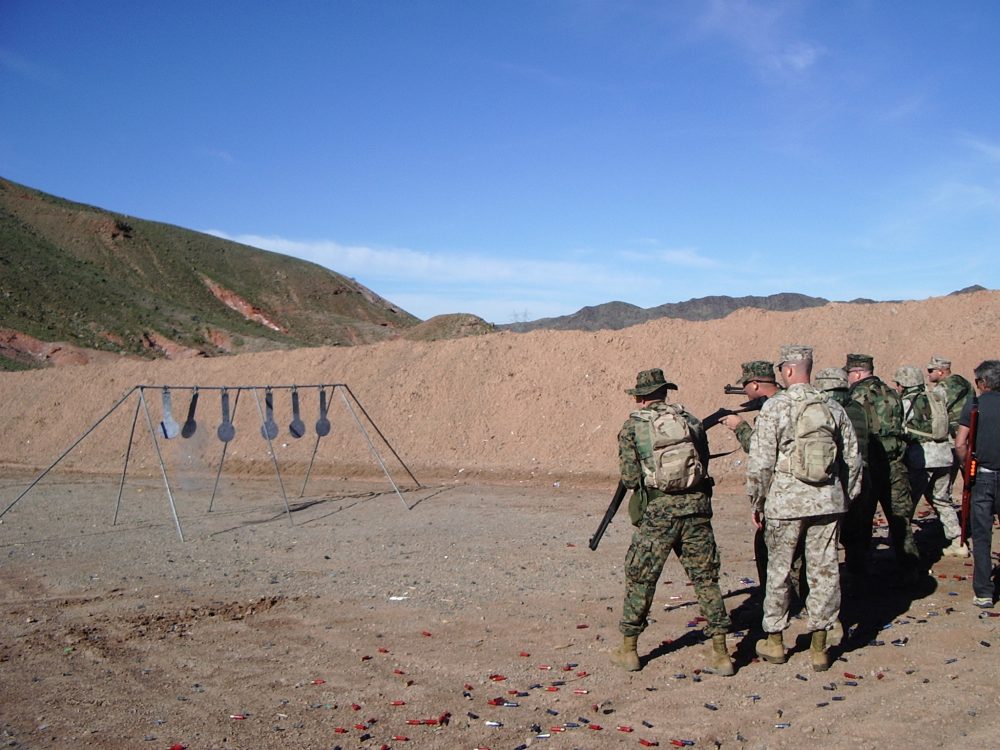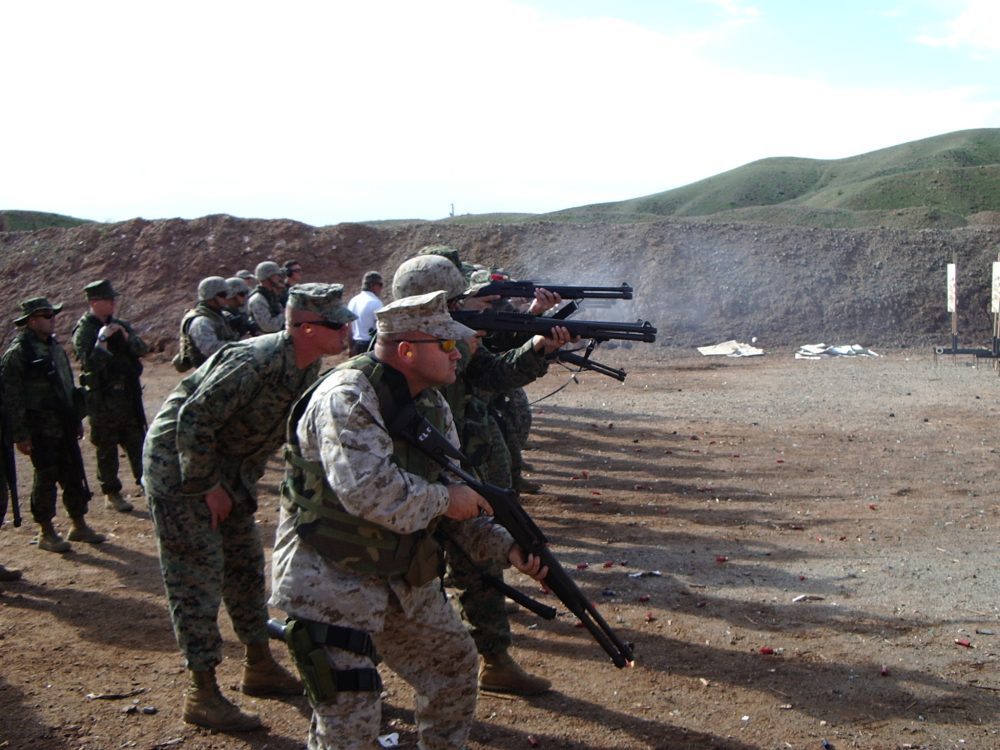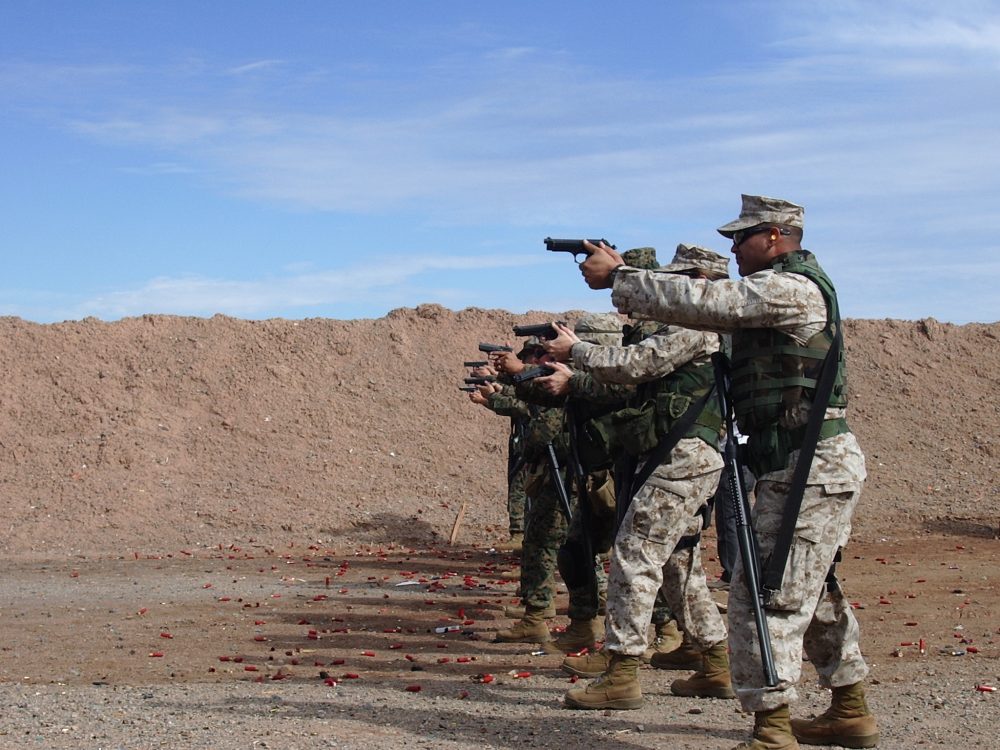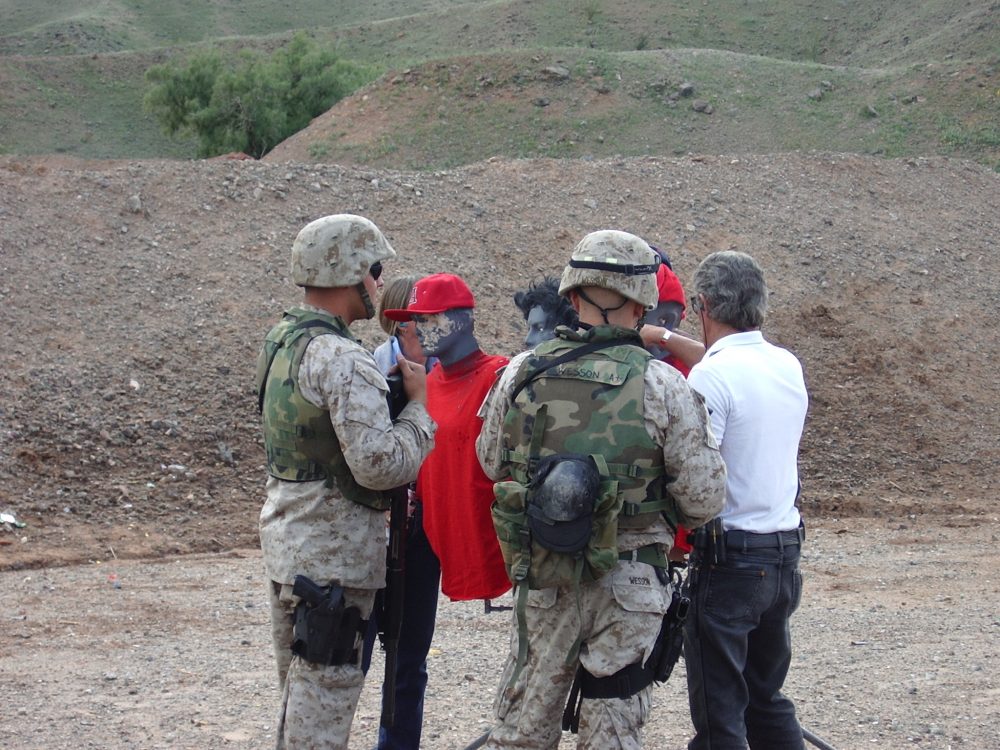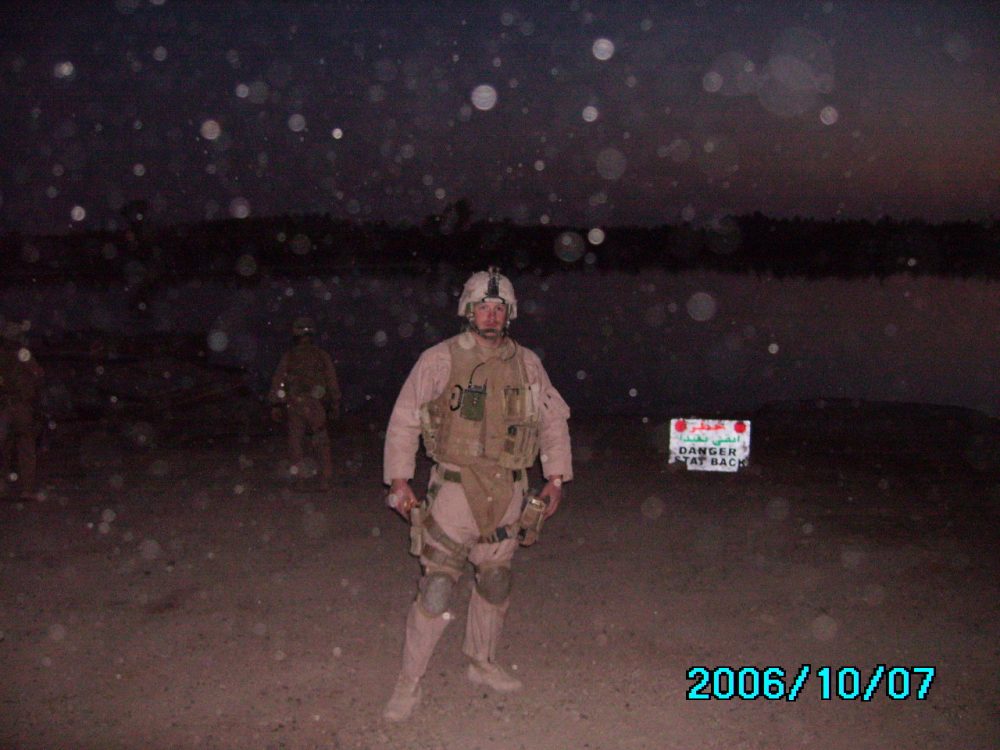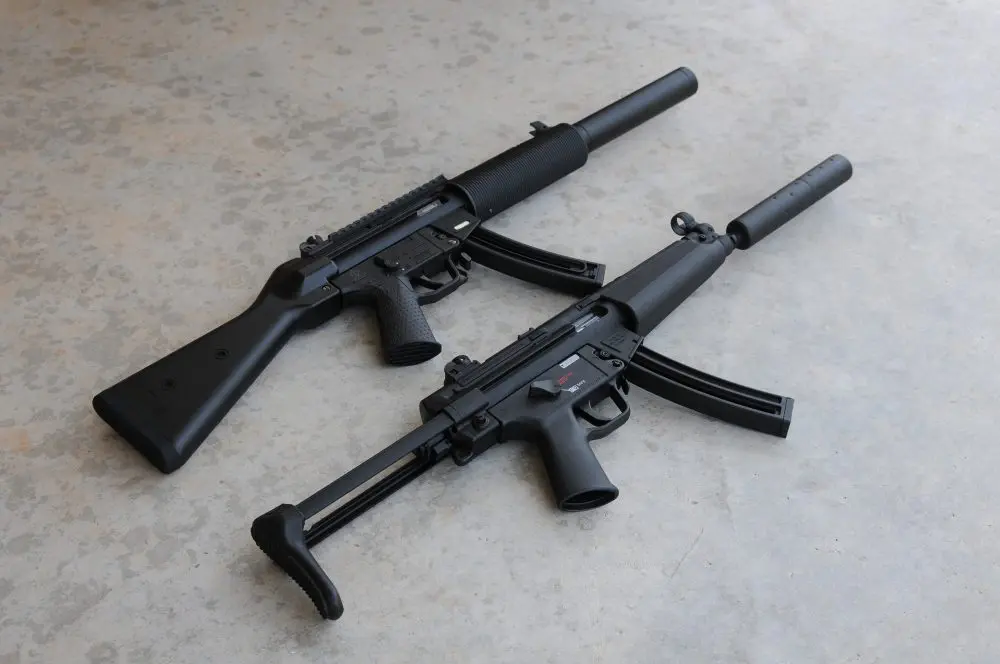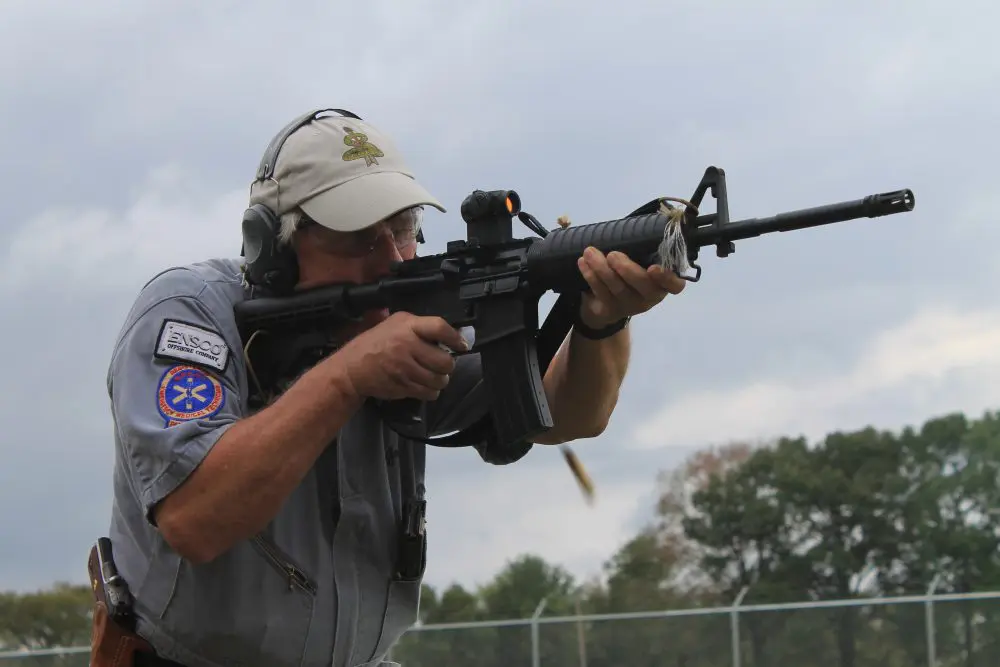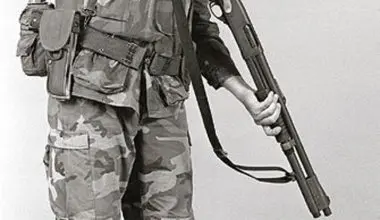“If there were such a thing as a doctorate in small arms, Louis Awerbuck would be one of a half-dozen people I think qualified for the title. He is a master of the art.” So stated LtCol Jeff Cooper, USMC, in 1999.
Thus, when some of the leadership within I Marine Expeditionary Force went looking for the right combat shotgun instructor to train their Marines how to fight with the M1014 Joint Service Benelli shotgun, they looked no further than Louis Awerbuck, president of Yavapai Firearms Academy.
Female Marine adjusts her stance due to excessive length of pull for M1014 shotgun.
Table of Contents
THE MARINES AND THEIR EQUIPMENT
Louis has conducted over six Stage I Shotgun classes for I MEF, with each class consisting of over 24 Marines. Many of the Marines were completely unfamiliar with the new M1014 Benelli shotgun, while a few had taken the Marine Corps’ 25-round familiarization fire (Fam-Fire) course. Fam-Fire is often an expedient way for military units to familiarize personnel with a weapon. Personally, I have always felt Fam-Fires were not an effective use of time and ammo. Firing 25 rounds through a new combat shotgun is barely enough to zero the ghost ring sights and pattern the barrel, let alone learn how to competently operate and fight with it.
For those unfamiliar with the M1014 Joint Service semi-auto shotgun (civilian designation Benelli M4), it was developed by Benelli Armi, Italy for Beretta, Inc. and procured for issue to all of the Armed Services. The M1014 was to replace the current inventory of pump-action shotguns throughout the Department of Defense beginning in late 2000. However, the U.S. Marine Corps—which is the Joint Service Manager for this procurement—is the only service to receive delivery. The other services have thus far decided to keep or purchase the utterly reliable Remington 870 and Mossberg 590 slide-action shotguns.
The M1014 Combat Shotgun system meets or exceeds all of the performance requirements that were set forth by the U.S. Government. Plus, with its 3.00-inch chamber, the M1014 can fire both 2.75-inch and 3.00-inch Magnum ammunition. The M1014 uses the new ARGO (Auto Regulating Gas Operated) Twin Operating System with rotating bolt head with dual locking lugs. The development of the ARGO Twin System, with its dual gas ports, pistons and cylinders, was the result of Benelli’s efforts to meet the U.S. military’s stringent operational and functional requirements for the Joint Service Combat Shotgun.
The M1014 Combat Shotgun is fitted with ghost ring iron sights, adjustable for windage and elevation without special tools. A MIL-STD 1913 accessory mounting rail is fitted to the top of the receiver of the weapon and allows the operator to mount all manner of targeting and sighting devices on the weapon in tandem with the iron sights.
During each of the three-day YFA Shotgun I classes, each Marine fires approximately 400 rounds of birdshot, 100 buck and 75 slugs loaded from a standard issue 12-round belt pouch or individually purchased, commercially produced MOLLE-compatible shotgun shell pouches.
Marines firing on Louis Awerbuck’s proprietary swinging targets.
SAFETY
The class starts with Louis stressing range safety. In fact safety is constantly stressed and is his foremost concern. Each day begins with a review of the four rules of gun safety. The Marines are reminded that anyone could call a ceasefire at any time if they felt there was an unsafe condition. Louis states that the most dangerous people on a range are those who handle weapons the most, as they are the most likely to get complacent. He also reminds Marines to mentally “turn on” every time they handle a weapon.
While Louis runs a “hot range” most of the time, when he needs the shotguns made safe, they are always cleared properly. Marines place their weapons on safe and properly sling them before moving off the range.
Marines conducting “Rolling Thunder” drill.
EQUIPMENT
Louis feels there are certain necessary modifications for a combat shotgun. These include: 1) properly sized stock, 2) sling, 3) fixed white light, and 4) extended magazine follower (if you have an extended magazine).
Stock
The stock should be 12 to 12.5 inches long. The M1014 fails in this regard as it is at least an inch to an inch and a half too long. Stocks can be too long, but you can’t go wrong with a short stock. Marines from Weapons Training Battalion in Quantico, Virginia, provided input on the length of pull for the M1014. They are primarily Bullseye competitors and thus thought the stock should be the same length as an M16A2/A4—even though Benelli offered a multi-position stock. Unfortunately this makes the stock too long for the majority of Marines when they wear their Interceptor vest and utilize a proper fighting stance.
Sling
The sling type (single point, two point or three point) should be based on mission parameters, but as with most things on a weapon, simple and durable are best. Additionally, all loose ends of the sling need to be tucked and taped to prevent obstruction of the bolt and subsequent malfunction. Currently there is no standard sling for the M1014, however, most units field it with a three-point sling. Because the sling is to a shotgun like a holster is to a pistol, it is important to utilize the best quality sling possible.
Lights
Shotguns should have a fixed white light for the best tactical feasibility in a combat environment. Any light, even a cheap model duct-taped to the stock or held in the support hand, is better than nothing. A dedicated SureFire forend light or their new Picatinny forend that allows for mounting a SureFire scout light (or other quality brand) is the best solution. Remember that dedicated lights can activate/deactivate at inopportune times, as the shooter’s hand slips on or off the momentary switch. Depending upon their location on either the sides of or underneath the barrel, lights will point under or beside the weapon’s actual point of aim. Under stress, the shooter may “aim” with the light and potentially miss the intended target. Sighted fire is still required. We learned that lighting up a target with bright white light can make the target look closer than it actually is.
Extended Magazine Tubes
The real purpose of extended tubes is not to load massive amounts of ammo, but to load to capacity minus one round. This allows room to load an alternative type of ammo (slugs, breaching or less than lethal) on demand. However, in combat, loading to capacity is encouraged. Plastic followers are preferred, as a stainless follower may score the inside of the magazine. An exception to this may be the new Vang Comp Systems stainless steel follower currently used by the DEA and Navy Special Warfare. While an inspection of magazine springs should occur during weapons cleaning, Louis has not seen any issues with “spring set” and does not believe it to be a concern.
Training included transitioning to the pistol.
THE TRAINING
Day 1
Training starts at 0800 on the range with a strong presentation of the subject areas previously discussed. After lunch the Marines begin handling the M1014s. They are walked though proper stance, dry firing and loading/unloading exercises.
Actual shooting starts with zeroing the shotguns at 25 yards with slugs from the prone—one of life’s great pleasures (note heavy sarcasm)—and patterning the shotguns out to 25 yards with 00B. This is followed by a Rolling Thunder shooting and reloading drill:
With five Marines shooting Louis’ proprietary hanging eight-inch round steel plates, the first Marine fires once and reloads. The next Marine fires once and reloads. This continues to the fifth Marine. The cycle starts again, with the first Marine firing twice and reloading and everyone else firing twice until the first Marine starts again by firing three times. This continues until every Marine is firing and reloading a string of five.
Next Louis has the Marines conduct a simple Man-on-Man drill. On command, each Marine fires and reloads. This helps induce a modicum of stress, as the Marines feel rushed to place rounds on target before another Marine beats them. The first day ends with the Rolling Thunder drill again around 1700. This time the Marines are encouraged to shoot and reload much more slowly and emphasize clean, smooth movements.
Awerbuck critiques Marines on success of final exercise.
Day 2
The second day also starts at 0800, but ends after a night shoot using white light flashlights. Louis normally starts off the training with Rolling Thunder, but quickly introduces 90- and 180-degree pivot techniques. Again, he has the Marines moving slowly and concentrating on technique. Louis also introduces malfunction clearing techniques, lateral movement, forward movement, and kneeling positions.
The Marines are then taught how to properly transition from a primary firearm (the shotgun) to a secondary firearm (a handgun), in this case the issue Beretta M9. There’s a lot of discussion of theory about when and why to transition. Additionally, because some of the Marines have had little experience with a handgun, Louis slowly warms them up by presenting the pistol from the holster and reholstering. Louis goes down the line with each Marine demonstrating proper presentation of the handgun. Louis makes sure every Marine is safe and can properly transition from their primary to their secondary firearm. Once all of the Marines have demonstrated good form, they practice placing the shotgun on safe, sweeping it to the side and drawing their sidearms. After a few live-fire runs, Louis works a handheld flashlight into the mix.
The night fire starts with an eight Marine Rolling Thunder as a warm up exercise. While this is usually not the first time for most Marines firing a firearm with a flashlight, it is the first experience for most Marines using a light with a shotgun. Most Marines find it difficult to integrate the light switch into the system of acquiring the target, aligning the sights, and shooting. After this warm up, the Marines form a line to hit a Salute Products self-resetting steel plate, which was lit up with a spotlight, at 50 yards with slugs.
This article is dedicated to LCpl Clinton Miller, USMC, MWSS-373 Incident Response Team Security Element, who bravely and selflessly gave his life on 11 December 2006 in the Al Anbar province of Iraq. Rest in Peace, Brother.
Day 3
The Marines start the third day of range work at about 65 yards with one slug on the same Salute Products self-resetting steel plate from offhand, drop to kneeling for another slug, a third from prone and then reload from prone and fire again. Louis shows the Marines how to selectively choose the ammo, 00B or slug, that they may need for a desired shot. This builds upon the basic skills they have already worked on of downloading or loading from the side port, but adds the requirement that they consider the effective range of the ammo they are using in relation to their target. The Marines begin this drill with dry practice. After dry practice switching ammo types, they run two-man drills consisting of hitting two plates at 25 yards with birdshot then quickly loading one slug and shooting a steel plate at 50 yards.
Depending upon range capabilities, Louis has the Marines fire four slugs kneeling at a steel plate at 100 yards. Most Marines are able to hit the steel target at that distance, which inspires greater confidence in their ability to use a shotgun for close to intermediate fighting distances. Louis then introduces the Marines to the Indoor Tactical Ready. Basically, this position points the muzzle low and next to, but not covering, the shooter’s foot. It’s used when moving through confined spaces, like urban close-quarters combat, where a Marine doesn’t want their muzzle revealing their position or being subject to a disarming attempt by an enemy combatant. The Marines practice moving into and firing from this position. All movement is very slow and deliberate, with safety again being the number one consideration. Louis tells the Marines that, when possible, withdrawing to cover to place greater distance between them and the threat could prove advantageous, as it will allow them more time to place an accurate shot and decrease the enemy’s chances of getting a lucky shot on them.
The final exercise that Louis conducts is one that involves numerous skills that have been taught to the Marines during the last three days. Louis sets up another of his proprietary Mirage Target Systems, which uses four 3-D Tac-Man plastic targets set up on a steel frame. They are arranged so two “no shoot” dummies are closest to the Marines, a “shoot” dummy is behind them and a “no shoot” is behind the other three. They are spaced close enough to each other that, if they were humans, they would have been touching each other’s sides and backs.
Two Marines simultaneously engage the target using slugs, with both Marines starting about 10 to 15 feet from the target. The first Marine can move laterally to the targets about three to five feet, while the other shooter can advance or retreat about 10 yards roughly parallel to the target. Restricted movement is necessary to provide safe shooting lanes. The rear two targets can be moved back and forth by Louis, forcing the Marines to maneuver and look for the proper shot while taking into account the fore and rear ground of the target. There is also a steel target frame between the targets and shooters, which further restricts the field of fire. Successful completion of this exercise requires solid communication between the two Marines.
TACTICAL REALITY
Gunfighting is primarily problem solving at high speed in a compressed time frame, with the added stress of someone trying to shoot you. The shotgun training provided to the Marines by Louis Awerbuck will ensure that they will be ready to blast hot slugs at turbaned heads when they hit the mean streets of Iraq and Afghanistan.
SOURCE:
Yavapai Firearms Academy
Dept. S.W.A.T.
P.O. Box 27290
Prescott, AZ 86312
(928) 772-8262
www.yfainc.com


